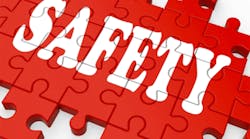Radar “sees” things long before they can be seen with the naked eye. It serves as both an early warning and a tracking device for military and civilian purposes. We all have a personal radar that we can use to warn us of things that can pose a threat to our safety. It’s called awareness.
No one wants to intentionally injure themselves, but there are times when we don’t fully utilize our personal radar to see and react to hazards, opening the door to near-misses, incidents and accidents.
There are, of course, times that reflexes kick in, and we instinctively change direction when we fear the outcome, i.e.:
- Catching our balance when we slip
- Duck when something flies at us
- When another driver cuts us off
The trouble with depending on our reflexes to keep up safe is that they vary with individuals, leaving some more vulnerable than others.
Even though we have a natural instinct to help keep us safe, instinct is not enough. We still do a lot of things without thinking that negatively can affect our safety. For instance, why would you ever:
- Use a fixed-blade box cutter, instead of a self-retractable cutter?
- Not wear required personal protective equipment?
- Wear inappropriate footwear on slippery surfaces?
- Carry items that block your view?
- Lift anything beyond your physical capabilities?
- Not report a safety hazard?
- Climb stairs without holding onto the railing?
- Not think before you act?
Why do we so often depend solely on our reflexes and instincts, instead of seeing problems far enough in advance, in order to have time to take appropriate action before they can harm us?
The simple answer is lack of situational awareness - some may call it inattention blindness - when we don’t see what’s right in front of us. Awareness is something that must be part of each of us. In my opinion, this is the most important element in safety. It must be encouraged and made meaningful via experience, down-to-earth training and information sharing that targets the reasons that cause accidents.
Radar, like most instruments, needs to be calibrated against known standards. On a personal basis, that standard is a commitment to awareness.
Sandy Smith, EHS Today editor, summarized the reasons for accidents:
- Companies complacent about safety
- Employees complacent about safety
- Human nature to ignore potential consequences of actions
- Personal protective equipment (PPE) isn’t comfortable
- Work environment not foolproof
To that list, I’d like to suggest the following reasons for accidents:
| Anger | Failure to recognize | No pre-planning |
| Blind spots | Inappropriate clothing | Physical limitations |
| Disregard for rules | Indecision | PPE (lack of, defective, not worn) |
| Distractions | Lack of training | Rushing |
| Emotion | Lack of guards/barriers | Skipping a step/shortcuts |
| Equipment failure | Lack of safety culture | Thinking mind can multi-task |
| Fatigue | Lack of supervision | Weather conditions |
| Failure to compensate | Loss of focus | Wrong/damaged tools |
It only is by addressing the reasons for accidents, that we can improve our state of awareness and, as a result, keep ourselves more alert to safety.
We are all human, and we make mistakes and poor choices. Use, as an example, lifting a box. Seems simple, right? Suppose the box is on the floor, doesn’t have hand holds, and weighs more than you anticipate.
If you simply bend over, grab the box, and lift it, you can put yourself at risk of a back injury. If you do this a number of times, it might take just one lift where your back says, “no more" and you have a back sprain, strain or spasm.
The use of punched-out hand holds on boxes, checking the weight before lifting, keeping your back straight and lifting with your legs are proven steps toward preventing a back injury. The same type of preparation holds true for any number of daily tasks to insure that you see and think before you act.
We need to know what the hazards are before we can see and act on them. Hence, the need for job hazard analyses and sharing of real-life experiences via interactive hazard awareness training as one proactive step toward a safer workplace.
